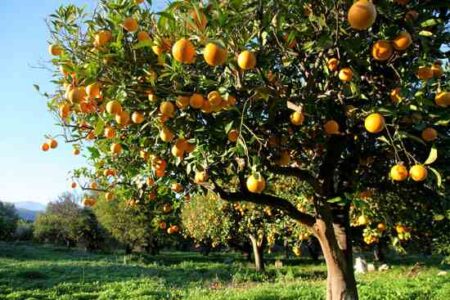• Asarum canadense
• (ASS-uh-rum can-uh-DEN-see)
• Family Aristolochiaceae
• Hardy perennial
European settlers arriving in North America had to do without many of the comforts of home from the Old Country. In the case of gingerroot (Zingiber officinale), however, they found a substitute in the rhizomes of an unrelated plant that they dubbed wild or Indian ginger (Asarum canadense).
Wild ginger is a member of the birthwort family. The genus Asarum comprises about seventy species of low-growing, stemless perennial herbs with aromatic rhizomes, most native to warm temperate eastern Asia, a few to North America, and one to Europe. A. canadense is native to eastern North American woodlands, surviving temperatures as low as -40°F.
Wild ginger rhizomes growing on top of the ground or just below the surface produce a new pair of soft, hairy, heart- or kidney-shaped leaves each year in early spring. They emerge light green and wrinkled, wrapped tightly around hairy leaf stalks, and gradually unfold and darken to medium green during the next several weeks. Three to 4 inches wide when they first open, the leaves may reach 71/2 inches across by fall atop sprawling leaf stalks up to 15 inches long. In April or May, a curious reddish brown flower with no petals appears between the two leaf stalks at ground level; it may even be hidden in leaf litter. The bell-shaped calyx, 1/2 inch long and 11/2 inches across, has three pointed lobes. The flower may be self-pollinated. The calyx persists until the big, oval, glossy grayish, green, or brown seeds ripen in four to six weeks. How the seeds are dispersed is unknown, although ants are known to carry away the seeds of the European species (A. europaeum).
Uses
Native Americans prepared decoctions and infusions of the wild ginger rhizome to bring on menstruation and regulate irregular heartbeat. The Meskwaki steeped crushed rhizomes and poured the liquid into the ear to relieve earache.
Early European settlers no doubt learned many medicinal uses from Native Americans. Perhaps their tooth powder made from the pulverized bark of black alder, bayberry, and black oak mixed with powdered wild ginger rhizome was also an Indian remedy. Their use of the candied rhizome and syrup to relieve flatulence and stomach cramps, however, likely derived from the similar use of gingerroot back home. Another Old World influence was the “doctrine of signatures”, according to which wild ginger’s kidney-shaped leaves were a sign that the plant was meant to be used to treat kidney disorders. Other folk uses of wild ginger included relieving fevers by inducing sweating and treating snakebite (hence one name for it, Canada snakeroot).
The rhizome is harvested in the fall. The fresh rhizome tastes pungent and earthy and has an unpleasant camphorous aroma. It probably wouldn’t substitute very well for fresh tropical ginger in a stir-fry. However, early settlers dried and grated the root as a substitute for gingerroot. Native Americans also used wild ginger to flavor their foods.
Wild ginger’s netted, solid green leaves lend a quiet note to shade or woodland gardens, whether the plants are massed as an edging, ground cover, or large clump or interplanted with ferns, black cohosh, and other taller shade lovers. Because wild ginger is hardy to Zone 2 and grows as far south as northern Alabama and Louisiana, many gardeners probably can find a home for it. European ginger, or asarabacca (A. europaeum), is hardy to Zone 4 and is highly ornamental with glossy evergreen or semievergreen leaves and 1/2-inch-long purplish green flowers. Its rhizomes were once used as a strong purgative and emetic, and its powdered leaves taken as snuff to treat headache and weak eyes.
Chinese wild gingers have long held a place in the traditional medicine of that country, and in Japan wild gingers were hung under the eaves of buildings to protect them from earthquakes and storms. Unfortunately, none of the dozens of strange and wonderful Chinese and Japanese species is readily available to gardeners in the United States at this time.
Growing it
Choose a spot in the shade with moist, humusy neutral to acid soil. Any degree of shade is fine. Amend the soil with compost, rotted leaves, or aged manure. Set plants with rhizomes just below the surface and mulch them well with leaves or salt hay. Keep plants well watered. The evergreen species tolerate drier soils. Slugs may be a problem.
Although self-sown seedlings are common and easily transplanted, propagating plants from seeds is a challenge. Start with freshly collected, well-washed seeds. Sow them in a cold frame, shaded seedbed, or pot sunk in the ground in a mixture of sandy soil and leaf mold. Keep the seedbed well watered. The seeds require a period of cold for germination. Move seedlings to a nursery bed for a year, then transplant to the garden the following spring.
Rooting cuttings can produce a lot of new plants in much less time than is required to grow plants from seed. In late spring or summer, cut off thin slivers of rhizome, each with a pair of the current year’s leaves attached, and set them in moist potting medium. Keep them moist. Roots should form within four to five weeks. Transplant the rooted cuttings to a nursery bed and then to their final site as described above.
Easiest of all is to divide established plants in spring or fall. Set 6-inch squares of plant or short lengths of rhizome a foot apart. Water and mulch them well.
Sources
• Plant Delights Nursery, 9241 Sauls Rd., Raleigh, NC 27603. Catalog $2.
• WE-DU Nurseries, Rt. 5, Box 724, Marion, NC 28752. Catalog $2.







